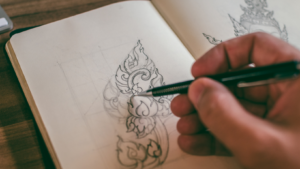Unlocking one’s creative potential can often feel like a daunting task. Yet, with the right guidance and a sprinkle of inspiration, it’s entirely achievable. This article delves into the fascinating world of sketch drawing ideas, providing a roadmap for those seeking to unleash their artistic prowess without having to resort to high tech gadgets.
Whether you’re a seasoned artist seeking fresh perspectives or a novice yearning to explore the realm of sketching, this piece serves as your guide. It’s linked with innovative ideas and tips that will not only elevate your sketching skills but also ignite your creative spark. Get ready to embark on an artistic journey that promises to be as enlightening as it is exciting.
Sketch:jgr9lxsmgmg= Drawing Ideas

Dipping a toe into the Sketch drawing ideas offers a fresh perspective in sketching and invigorates the creative process. This section uncovers the concept foundation and the potential benefits embedded in this approach.
Unraveling the concept behind Sketch drawing ideas involves appreciating the intersection of art and innovation. It’s about leaning on a myriad of inspirations, unleashing the artist’s creative mind, and translating that energy onto a sketchpad. The technique promotes variety, spontaneity, and exploration of traditional sketching while also helping to unplug for wellness in this hectic and rapid world.
With Sketch drawing ideas, one doesn’t stick to predesigned patterns or styles. Instead, a sketch artist sees a world of endless possibilities, where every image, idea, or even a passing thought can morph into an intriguing art piece. Effective utilization of the technique turns a blank canvas into a platform for individual expression, where every stroke has a unique story to tell.
Key Features and Benefits

Sketch drawing ideas come equipped with numerous features that give an edge to the artist. It nurtures creativity, fosters originality and promotes perspective development. As an artist dives into the practice, he or she discovers a whole different dimension to drawing that greatly enhances their artistic endeavors.
One striking feature of this approach is its encouragement of freedom of expression. It fosters an environment where an art piece isn’t confined by rigid guidelines or standard norms, allowing the artist to explore individual uniqueness. Moreover, it instills a sense of novelty in sketches. It says goodbye to monotonous drawing routine, making every sketch a fresh endeavor, thus keeping the artist engaged and passionate about their work.
The benefits of embracing the Sketch drawing ideas are considerable. Artists can explore a wider range of subjects, experiment with different styles, and carve out a unique artistic footprint. Furthermore, it facilitates a deeper understanding of the dynamics of drawing, which elevates the sense of satisfaction derived from the artistic process. The approach opens up a new world of opportunity where the artist’s distinctive vision, creativity, and passion reshape the boundaries of conventional sketching.
Techniques to Enhance Your Sketching Skills

After selecting the ideal tools for sketching, it’s crucial to refine the techniques to master Sketch drawing ideas. This section delves into enhancing light, shadow, perspective, and depth in sketching.
Grasping the concept of light and shadow lends realism to sketches. Light and shadow in a sketch are products of a light source on the object being sketched. Shadows usually consist of two parts, the shadow that the object casts on a surface, often labeled as ‘cast shadow,’ and the darker side of the object itself, termed the ‘form shadow.’ Determining the direction, intensity, and color of the light will influence the depiction of shadows, creating a three-dimensional image on a flat surface.
Han Hampton’s book, “Drawing with Light and Shadow: Sketching Every Day,” is an insightful guide that elaborates on harnessing the potential of light and shadow. It provides practical applications under various lighting scenarios, enhancing sketching technique, depth, texture, and tonal value.

